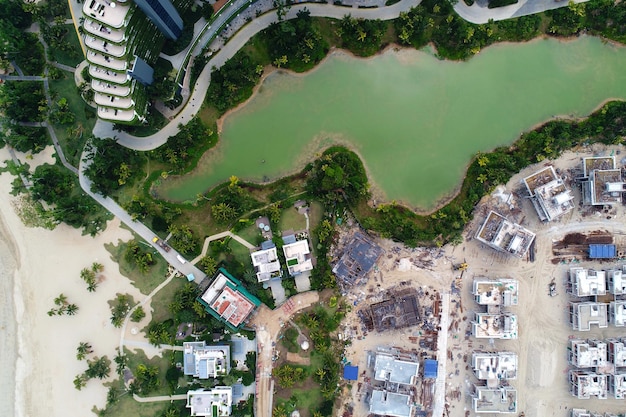How US Businesses Can Prepare for Climate Disasters: A 5-Year Guide

US businesses can prepare for the expected increase in climate-related disasters in the next 5 years by implementing robust risk management strategies, investing in resilient infrastructure, developing comprehensive emergency response plans, and embracing sustainable practices to mitigate future impacts.
How Can US Businesses Prepare for the Expected Increase in Climate-Related Disasters in the Next 5 Years? The escalating frequency and intensity of climate-related disasters present a significant challenge for businesses across the United States. Preparing for these events is no longer optional; it’s a critical component of ensuring business continuity and long-term sustainability. This guide outlines actionable steps US businesses can take to safeguard their operations and employees.
Understanding the Rising Threat of Climate-Related Disasters
Climate change is no longer a distant threat; its impacts are being felt across the US in the form of more frequent and severe weather events. From hurricanes and floods to wildfires and droughts, these disasters can disrupt supply chains, damage infrastructure, and endanger lives. Understanding the nature of these risks is the first step in preparing for them.
Increased Frequency and Intensity
The data is clear: climate-related disasters are becoming more common and more intense. Rising sea levels, warmer temperatures, and altered precipitation patterns are contributing to these changes. This means businesses need to prepare for events that may have been rare or unprecedented in the past.
Regional Variations in Risk
The specific risks vary by region. Coastal areas are vulnerable to hurricanes and flooding, while the West faces wildfires and droughts. The Midwest can experience severe storms and tornadoes. Businesses need to understand the specific risks in their geographic area and tailor their preparedness plans accordingly.
- Coastal Regions: Focus on hurricane preparedness and flood mitigation.
- Western States: Prioritize wildfire prevention and water conservation.
- Midwest: Prepare for severe storms, tornadoes, and flooding.
Preparing for climate-related disasters means acknowledging the increasing risks and understanding how they vary regionally. This knowledge forms the foundation for developing effective preparedness strategies that protect businesses and communities.
Conducting a Comprehensive Risk Assessment
A thorough risk assessment is crucial for understanding the potential impacts of climate-related disasters on your business. This involves identifying vulnerabilities, evaluating potential damage, and prioritizing areas for improvement. A well-conducted assessment provides a roadmap for developing targeted preparedness measures.

Identifying Vulnerabilities in Your Business
Start by identifying potential vulnerabilities in your operations. This includes assessing the physical location of your facilities, the resilience of your supply chains, and the potential impact on your workforce. Consider how different types of disasters could affect each of these areas.
Evaluating Potential Damage Scenarios
Once you have identified vulnerabilities, evaluate the potential damage that could result from different disaster scenarios. This involves estimating the financial losses, operational disruptions, and potential safety risks. Consider both direct impacts, such as property damage, and indirect impacts, such as supply chain delays.
Conducting a comprehensive risk assessment enables businesses to understand their vulnerabilities, evaluate potential damage scenarios, and prioritize risk mitigation efforts, ensuring a more resilient and prepared organization.
Investing in Resilient Infrastructure and Facilities
Investing in resilient infrastructure and facilities is a proactive approach to mitigating the impact of climate-related disasters. This includes strengthening buildings, implementing flood control measures, and investing in backup power systems. By building resilience into your physical assets, you can minimize damage and ensure business continuity.
Strengthening Buildings and Facilities
Assess the structural integrity of your buildings and facilities and identify areas for improvement. This may involve reinforcing walls, roofs, and foundations to withstand high winds, floods, and earthquakes. Consider using building materials that are more resistant to fire and water damage.
Implementing Flood Control Measures
If your business is located in a flood-prone area, implement flood control measures to protect your property. This may involve installing flood barriers, elevating critical equipment, and improving drainage systems. Consider purchasing flood insurance to cover potential losses.
- Reinforce Building Structures: Strengthen walls, roofs, and foundations.
- Install Flood Barriers: Protect properties in flood-prone areas.
- Invest in Backup Power: Ensure continuity during power outages.
Investing in resilient infrastructure is essential for minimizing the impact of climate-related disasters, safeguarding assets, and ensuring operational continuity.
Developing a Comprehensive Emergency Response Plan
A comprehensive emergency response plan is vital for ensuring the safety of your employees and the continuity of your operations during a disaster. This plan should outline procedures for communication, evacuation, and business recovery. Regular training and drills are essential for ensuring that everyone knows how to respond effectively.
Establishing Communication Protocols
Establish clear communication protocols for notifying employees of emergencies and providing updates during a disaster. This may involve using email, text messages, and social media to reach employees quickly. Designate a communication team to manage information flow and address inquiries from employees, customers, and stakeholders.
Creating Evacuation Procedures
Develop detailed evacuation procedures for your facilities, including designated evacuation routes, assembly points, and emergency contacts. Conduct regular evacuation drills to familiarize employees with the procedures and identify potential bottlenecks. Ensure that all employees know how to assist those with disabilities or special needs.

Developing a detailed emergency response plan is critical for protecting employees, minimizing disruptions, and ensuring a swift recovery following climate-related disasters.
Embracing Sustainable Practices to Mitigate Future Impacts
Adopting sustainable practices not only reduces your environmental footprint but also enhances your business’s resilience to climate change. This includes conserving energy and water, reducing waste, and investing in renewable energy sources. By embracing sustainability, you can minimize your contribution to climate change and improve your business’s long-term viability.
Conserving Energy and Water
Implement measures to conserve energy and water in your operations. This may involve upgrading to energy-efficient equipment, installing water-saving fixtures, and educating employees about conservation practices. Consider conducting an energy audit to identify opportunities for reducing your consumption.
Reducing Waste and Promoting Recycling
Minimize waste generation by implementing recycling programs and reducing the use of disposable products. Encourage employees to recycle paper, plastic, and other materials. Consider implementing a composting program for food waste. Partner with suppliers who use sustainable packaging and reduce waste in their operations.
- Conserve Resources: Reduce energy and water consumption.
- Minimize Waste: Implement recycling and waste reduction programs.
- Invest in Renewables: Transition to solar, wind, and other clean energy sources.
Embracing sustainable practices is not just environmentally responsible; it also enhances your business’s resilience and positions you for long-term success in a changing climate.
Securing Insurance Coverage and Financial Protection
Adequate insurance coverage and financial protection are essential for recovering from climate-related disasters. Review your insurance policies to ensure that they cover potential losses from hurricanes, floods, wildfires, and other events. Consider purchasing business interruption insurance to cover lost revenue during a disaster.
Reviewing Insurance Policies
Work with your insurance provider to review your policies and ensure that they provide adequate coverage for potential climate-related risks. Pay attention to policy exclusions and limitations, and consider purchasing additional coverage if needed. Keep your insurance policies up to date to reflect changes in your business operations and asset values.
Establishing a Disaster Recovery Fund
Set aside funds in a dedicated disaster recovery fund to cover expenses not covered by insurance. This fund can be used to pay for emergency repairs, temporary housing for employees, and other unforeseen costs. Consider establishing a line of credit that you can access quickly in the event of a disaster.
Securing ample insurance coverage and building a strong financial safety net are vital for ensuring that your business can weather climate-related disasters and recover swiftly.
| Key Point | Brief Description |
|---|---|
| ⚠️ Risk Assessment | Identify vulnerabilities and potential damage. |
| 🏗️ Resilient Infrastructure | Strengthen buildings, implement flood control. |
| 🚨 Emergency Plan | Establish communication, evacuation procedures. |
| 🌱 Sustainability | Conserve resources, reduce waste, use renewables. |
Frequently Asked Questions (FAQ)
▼
The US faces various climate-related disasters, including hurricanes, floods, wildfires, droughts, and severe storms. Coastal regions are prone to hurricanes and flooding, while the West faces wildfires and droughts.
▼
Businesses can conduct a comprehensive risk assessment to identify potential vulnerabilities. This involves evaluating the physical location of facilities, the resilience of supply chains, and the potential impact on the workforce.
▼
Cost-effective measures include strengthening building structures, implementing flood control measures, and investing in backup power systems. These investments can minimize damage and ensure business continuity during disasters.
▼
An emergency response plan ensures the safety of employees and the continuity of operations during a disaster. It should outline procedures for communication, evacuation, and business recovery, with regular training and drills.
▼
Sustainable practices reduce a business’s environmental footprint and enhance resilience. Conserving energy and water, reducing waste, and investing in renewable energy sources minimize contributions to climate change and improve long-term viability.
Conclusion
Preparing for the increase in climate-related disasters is a critical imperative for US businesses. By understanding the risks, conducting thorough risk assessments, investing in resilient infrastructure, developing comprehensive emergency response plans, and embracing sustainable practices, businesses can safeguard their operations, protect their employees, and contribute to a more sustainable future.





